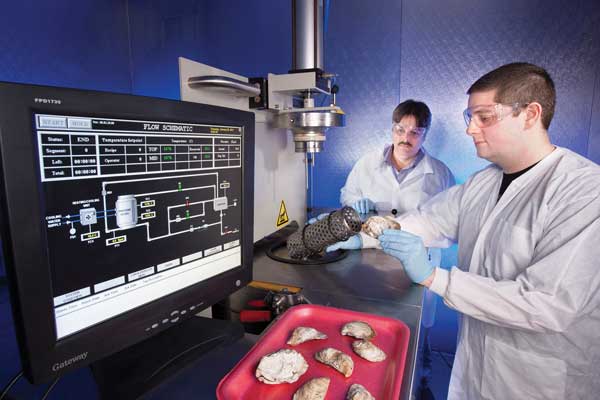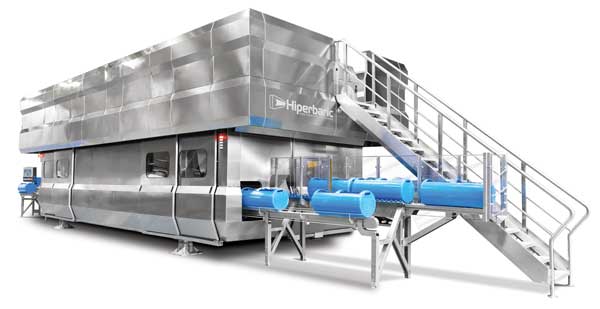Putting Oysters Under Pressure
PROCESSING
According to a recent paper published in Innovative Food Science and Emerging Technologies Journal, high pressure processing (HPP) is the most commercially important food processing technology in use now and is anticipated to remain of equal or greater importance during the next five to 10 years. This month’s column reviews the theory and current applications of HPP for oysters to improve their safety and quality. This column is coauthored by David Kingsley, a molecular biologist at the U.S. Dept. of Agriculture’s (USDA), Agricultural Research Service (ARS), Food Safety and Intervention Technologies unit in Dover, Del. He is an active researcher in HPP processing of shellfish, including oysters. Although HPP was originally developed in the late 19th century as an alternative nonthermal method for pasteurizing milk, this technology is only now coming to the forefront as a cold pasteurization method for certain meat and produce products.
 An Overview
An Overview
HPP is an alternative to thermal or chemical processing, which can adversely impact the quality of food. HPP is a nonthermal process that works by squeezing water at very high pressures—approximately two to six times the water pressure found at the bottom of the Marianas Trench. Packaged foods enter pressure chambers in the HPP unit, after which the vessel is filled with water. Once the tank is filled, up to 87 kpsi can be applied to the food over a period of 1–15 min. In some cases, the pressure is applied intermittently, while in most cases it is constant. Shape and integrity of the food can remain unchanged because the pressure is uniformly applied to every part of the product. During pressurization, proteins and enzymes can be denatured and noncovalent bonds can be broken. In addition, bacterial pathogens, as well as some spoilage bacteria, and viral pathogens, can be inactivated. In this way, shelf life can be extended without the need for preservatives. The sensory quality and nutrition of foods processed by HPP is generally very good and often better than that obtained using traditional processing methods.
Today there are numerous HPP-treated food products on grocery store shelves. HPP is very effective for retaining raw uncooked character and flavor of fruit and vegetable products, including fruit salad, smoothies, jellies, jams, and fruit juices. For example, high pressure processed juices better retain “fresh squeezed” character as compared to thermally pasteurized juices. Pressure-treated guacamole is another very common HPP-treated product. For ready-to-eat meat products, HPP can be ideal for use as a final kill step after the meat has been packaged. Use of an HPP kill step permits reduced cooking temperatures for some meat, such as chicken, resulting in better flavor and texture. Some large U.S. sandwich chains use HPP for all their deli meats to ensure food safety. In addition, shellfish, including oysters, which are the focus of this column, are currently commercially processed using HPP.
Food Safety Benefits
Perhaps the original ready-to eat-food that many people still enjoy eating is a fresh-shucked oyster. Oysters are efficient filter feeders that consume microscopic phyto- and zooplankton as they grow. This sponge-like property also causes them to soak up and bioconcentrate pathogenic bacteria and viruses that may be present. As a result, pathogen concentrations within shellfish meat can be a thousand-fold higher than the surrounding estuary waters. Today consumption of raw oysters on a per meal basis is still much riskier than other foods, principally because of environmentally ubiquitous vibrio bacteria and fecal viruses, such as human norovirus. Vibrio vulnificus (Vv) and Vibrio hemolyticus bacteria can cause gastrointestinal illnesses. Also in the case of Vv, ingestion of high levels of bacteria found within oysters by persons not in good health can result in serious illness; a handful of deaths result from it each year. Due to the risk of Vv, the state of California requires “postharvest treatment” of all oysters imported from states that have Vv risk. Currently HPP is an approved intervention technology for Vv within shellfish. High pressure is applied for 3 min at 42 kpsi. This treatment reduces Vv to “nondetectable levels.” While not specifically approved for Vibrio hemolyticus, HPP at 45 kpsi for a few minutes is known to be sufficient to inactivate these bacteria as well.
For the past decade and a half, the USDA, ARS, Microbial Safety of Aquaculture Products Center of Excellence program in conjunction with food safety researchers at the University of Delaware, Virginia Tech, Emory University, Ohio State University, and Delaware State University have pioneered inactivation of foodborne viruses by HPP with specific interest in utilizing HPP as an intervention for shellfish. Initial work focused on proof of principle that viruses can be inactivated by HPP using a propagable strain of Hepatitis A virus (HAV), a human norovirus (HuNoV) surrogate, feline calicivirus (FCV), and murine norovirus (MNV). FCV was inactivated at pressures comparable to those used for commercial HPP for shellfish. Although both MNV and HAV are resistant to pressure levels used for Vibrio intervention (42 kpsi), HPP at 60 kpsi inactivated 3 logs and 4 logs of both HAV and MNV within oysters. One key question remaining was could HPP of oysters inactivate HuNoV? HuNoV cannot be propagated in the lab, making its inactivation impossible to measure in the lab. To address this, a human volunteer study was performed at Emory with oysters injected with HuNoV. Results indicated that 90 kpsi completely killed HuNoV based on protection of volunteers from illness, and results indicated that 60 kpsi reduced virus levels. More recently, HPP inactivation of HuNoV was confirmed in piglets following treatment at 60 kpsi.
Food Quality Benefits
Several food quality benefits are achievable when processing oysters with HPP. The first benefit of HPP treatment is the “automatic” oyster shucking. Processors can use HPP ranging from 30–50 kpsi to denaturize proteins in the adductor muscle of oysters. Using HPP, the muscle, which is responsible for closing the shell, will not be able to contract and the oyster will open. This exposes the meat for easy extraction, resulting in a significant yield increase and eliminating the need for potentially dangerous knife manipulation while opening the shells. In addition, HPP treatment efficiently separates the meat from the shell to give a perfectly shucked intact oyster. Finally, the oysters can be banded (sealed by a band prior to processing) in order to prevent loss of the oyster liquor when pressurized. This adds natural flavor and liquid weight to the processed oyster. HPP can also be exploited to add flavors to oysters with hot sauce or citrus flavors.
 Commercial HPP Processing
Commercial HPP Processing
At the end of 2015, there were approximately 315 HPP units running in the world, and it is estimated that number will grow to 400 units this year (www.hiperbaric.com). Miami-based Hiperbaric is one of the leading suppliers of HPP machines for the food and beverage industry. The company’s largest system, the Hiperbaric 525, was launched in 2013 and is able to achieve throughputs of 3,000 kg or liters per hour of packaged food or beverages. Another large company that manufactures HPP food machines is Avure Technologies, Erlanger, Ky. Avure has introduced the first expandable HPP machine, which allows for future expansion dependent on production capacity needs from 40 million pounds to 70 million pounds of output per year. Avure also has a worldwide network of toll processing facilities to process foods. These toll processing facilities, and others, offer benefits such as lower startup costs and long-term investment requirements, as well as faster start-up timelines to food companies. In addition to Hiperbaric and Avure, there are numerous other manufacturers of HPP equipment.
Currently there are several commercial manufacturers of HPP processed oysters in the United States. Three of these companies are Motivatit Seafoods, Houma, La., which markets Gold Band Oysters, Prestige Oysters Inc., which markets Treasure Band oysters, and Nisbet Oyster Co., Willapa Bay, Wash., which markets Goose Point Oysters. The HPP-processed oysters produced by these companies and numerous others have a shelf life of at least 17 days.
Future Directions for HPP
The main obstacle to increased adoption of HPP processing is cost. The price of HPP systems is generally higher than pasteurizers. Future innovation in HPP equipment and wider availability of toll processing facilities for HPP processing are anticipated to decrease costs in the future. From a sensorial, nutritional, and safety perspective, HPP is an excellent food processing technology with a very bright future for oysters and a myriad of other foods and beverages.
 Tara McHugh, PhD, Contributing Editor
Tara McHugh, PhD, Contributing Editor
Research Leader, USDA Agricultural Research Service, Albany, Calif.
[email protected]
David Kingsley, PhD, is a molecular biologist with the U.S. Dept. of Agriculture’s Agricultural Research Service, Food Safety and Intervention Technologies unit in Dover, Del. ([email protected]).
References
Jermann, C. et al. 2015. “Mapping Trends in Novel and Emerging Food Processing Technologies Around the World.” Innovative Food Sci. Emerging Technol., October.


